Beneficial nematodes are a healthy and all-natural proactive pest solution that kills bugs before they ever have a chance to destroy your plants. In this post, I’ll tell you exactly how they work and when to apply them. Then I’ll give you step-by-step instructions for how to spread nematodes in your garden.
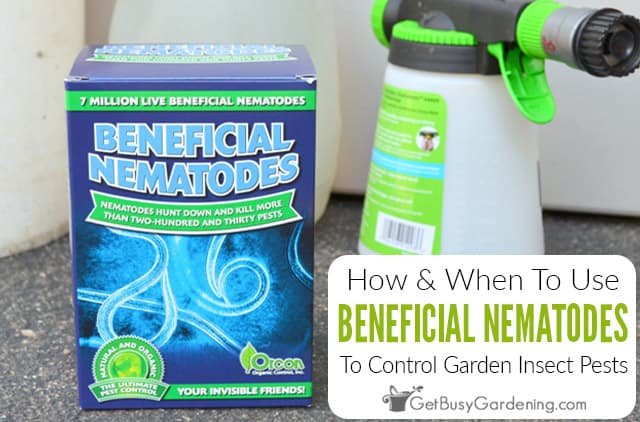
Skip the chemical pesticides this season. Beneficial nematodes are a totally organic, chemical-free solution to your garden pest insect problems.
With these natural predators, you can control damaging bugs before they ever emerge from the soil.
The best part is that they only attack the bad bugs, and won’t harm pollinators or other beneficial insects.
These helpful nematodes will kill the grubs that grow into detrimental insects before they ever have a chance to eat your plants.
When applied correctly, they will continue to protect your garden all season long.
Below, I will tell you how they work, and show you when and how to apply beneficial nematodes in order to keep your garden pest-free.
What Are Beneficial Nematodes
Beneficial nematodes are microscopic organisms that are commonly used to control many different types of garden insect pests.
They live in the soil, where they are found naturally. Plus, they’re completely organic, non-toxic, and safe to use around people and pets.
Types Of Beneficial Nematodes
It’s important to understand that there are different types of beneficial nematodes, and their prey can vary by species.
All kinds will feed on various pest insect larvae, but they don’t feed on everything.
So, for best results, you should know what type of insect pest you’re targeting. That way, you can be sure to get the best type of nematodes that prey on that specific pest.
Check the package to make sure the kind you buy targets your specific insect pest.
If you have more than one kind of bug you want to get rid of, you may need to apply different species of beneficial nematodes. Don’t worry, they won’t harm each other.
Some packages come with several different species mixed together, so one application can target a larger array of bad bugs. So, if you’re targeting multiple pests, you may want to buy a mixed package.
What Do Beneficial Nematodes Look Like?
They are invisible to the naked eye. However, if you were to look at them under a microscope, beneficial nematodes look like long roundworms.
Sounds gross, I know, so it’s probably a good thing that we can’t see them. Don’t worry, they won’t crawl on you or anything like that. They live underground.

Are Nematodes Good For Your Garden?
There’s no question that beneficial nematodes are good for your garden. They help to naturally control tons of different pest insects.
That means you don’t have to worry about using harmful pesticides in your yard. Yay!
However, if you don’t have any trouble with bad bugs, then there’s no reason to apply them.
They don’t have any other benefit to the garden, and will only die off if there’s not a large population of pray for them to feed on.
What Do Beneficial Nematodes Kill?
Beneficial nematodes kill grubs and other insects when they’re in their larval and pupal stages in the soil, before they emerge as adults.
Though they attack most soil-dwelling bugs, they leave earthworms alone.
Since they kill over 200 different types of insects, I won’t attempt to name them all here.
But, on a large scale, beneficial nematodes can be used to control fleas, beetles, ants, flies, termites, and many other types of undesirable bugs.
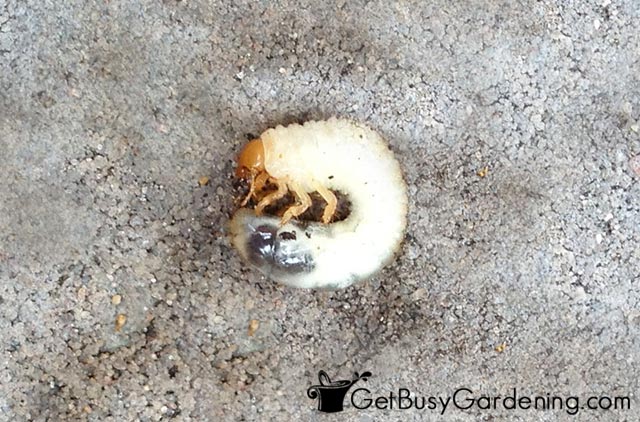
Do Beneficial Nematodes Really Work?
Yes, absolutely. It’s hard to trust that they are doing anything, since you can’t see them. And you’re not going to see any dead bugs around either, because they all die underground.
But after a few weeks, you should start to notice the population of the adult bugs is beginning to decline.
I’ve definitely seen a significant decrease in the amount of flea beetles and ants in my gardens, and the Japanese beetle population seemed smaller the last few years too.
How Do They Work?
They are parasites that enter the body of their host, and then release a type of bacteria that kills them.
The beneficial nematodes then feed on the dead grubs from the inside out. Once they’re done, they move on to find another host.
Sounds horrible, doesn’t it. Well, there’s more! They also mate inside the host, where the babies feed on the dead insect as they grow as well. Eek! I’m glad I’m not a bug.
Once the pest population dies down, the nematodes also start to naturally die off. So, it’s usually best to reapply at least once a year for recurring pest infestations.
How To Use Beneficial Nematodes
In this section, I’ll give you some general guidelines for when and how to apply beneficial nematodes in your yard and garden.
But, you should always follow the instructions on the package. Those will give you the best methods for mixing and applying your purchased species.
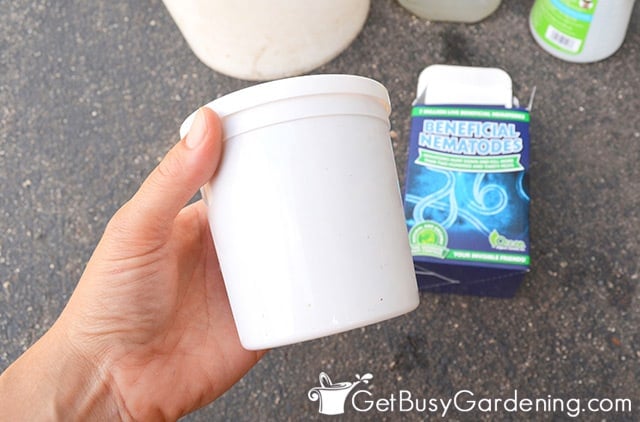
When To Apply
If you’re wondering what time of the year to apply beneficial nematodes, it somewhat depends on what you’re trying to control.
Once the adult bugs emerge, these useful parasites do not affect them. So it’s important to apply the nematodes at the right time, while the larvae is still in the ground.
So, for example, late spring or early summer is the best time to apply them for Japanese beetles, because the larvae are very close to the soil surface at that time.
Late summer into early fall is also a good application time, so they’ll kill the soil-dwellers before they have a chance to overwinter.
As for the time of day to do it, beneficial nematodes travel best when the soil is moist, and direct sunlight will kill them.
So, if you can, plan to apply them on a cloudy and/or rainy day when the temperature is between 45-95 degrees F.
If it’s not cloudy, then the best time of the day to do it is after the sun goes down in the evening, to avoid any direct sun exposure.
How To Apply
Applying beneficial nematodes is a pretty easy process. Before starting, make sure you read the instructions on the package. But below are the basic steps.
It’s important to apply them right after mixing with water. You can’t store them after they’ve been activated. So allow at least one hour of time in order to complete all of these steps.
You don’t need any fancy equipment, and will probably have the necessary supplies around the house.
Supplies Needed:
- Beneficial nematodes
- Hose end sprayer attachment or hand pump sprayer
- Garden hose (if using a hose sprayer)
- 5 gallon bucket
- Water
- Strainer or screen material (optional: if yours came in packing material)
Step 1: Activate the beneficial nematodes – First, pour the container of nematodes into water, and allow them to soak. This will activate them.
To do this, pour about 1 gallon of tepid water into a 5 gallon bucket, and then add the contents of the package. Stir it all together, and let it sit for 30 minutes.
Step 2: Water the yard – While your beneficial nematodes are soaking, water your yard and gardens thoroughly (if it’s not raining).
Do not skip this step because they travel best in damp conditions. The soil should be moist, but not saturated or soggy.
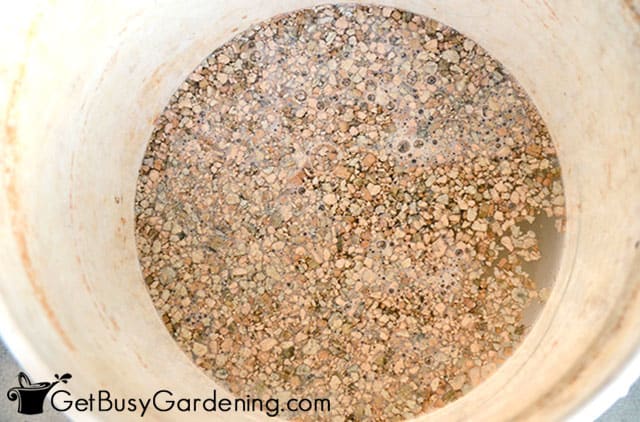
Step 3: Strain out the packing material – If your nematodes came in packing material like mine did, then you should strain out the largest pieces to avoid clogging your sprayer.
You can use a kitchen strainer or a piece of old screen material to do this. Remember, they are invisible to the naked eye.
So you’re not going to see anything swimming around in the water. You just have to trust that they are in there.
Step 4: Add the mixture to your sprayer – Fill your hose sprayer attachment or with the water and nematode mixture, or add a small amount to your hand pump.
If you’re using a manual pump sprayer, you’ll need to add more water to the mixture to further dilute it, so the application will go farther. To avoid blockage, remove any screens or filters in your sprayer.
Step 5: Apply the beneficial nematodes – Now you can simply walk all around, spraying the mixture in your yard and gardens as you go.
Shake the sprayer once in a while as you’re applying to make sure the beneficial nematodes are being distributed evenly, and not sinking to the bottom.
Step 6: Water your yard again – Once you’re done spraying, thoroughly water your yard and gardens again, so the nematodes have plenty of moisture to move around.
Also, make sure to keep the soil moist for a week or two if there’s no rain in the forecast.
FAQs
In this section, I’ll answer some of the most frequently asked questions about using beneficial nematodes for pest control. If you can’t find an answer to your question here, then ask it in the comments below.
How long does it take for nematodes to work?
Though it only takes a day or two for beneficial nematodes to start killing pests, it takes a bit of time before you’ll start to notice a change.
You should start to see a difference in about 2 weeks, as the emerging adult populations slowly begin to decrease.
Do beneficial nematodes survive winter?
Beneficial nematodes go dormant during the winter, and can survive until spring. However, in climates with harsh winters (like ours here in Minnesota), many of them will die off.
So the population can decrease quite a bit during the winter. That’s why it’s a good idea to reapply them every year.
Are beneficial nematodes harmful to humans?
No. Beneficial nematodes are completely harmless to humans, pets, and other animals, as well as insects like ladybugs, bees, and other pollinators, birds, fish, amphibians, and reptiles.
Is it safe to apply beneficial nematodes in my vegetable garden?
Yes! Beneficial nematodes are all-natural, non-toxic, and completely safe to use in any area of your yard, including the vegetable garden.
Beneficial nematodes are a great way to use nature to control harmful garden bugs. With only one application each year, they will go on killing the pests, all while leaving your beneficial insects and pollinators alone.
More Posts About Garden Pest Control
- Using Eggshells As Organic Pest Control
- How To Release Ladybugs Into Your Garden
- How To Protect Grapes From Birds & Insects
- All About Ladybugs & Why They’re Good For Your Garden
Share your tips or experience with using beneficial nematodes in the comments below.
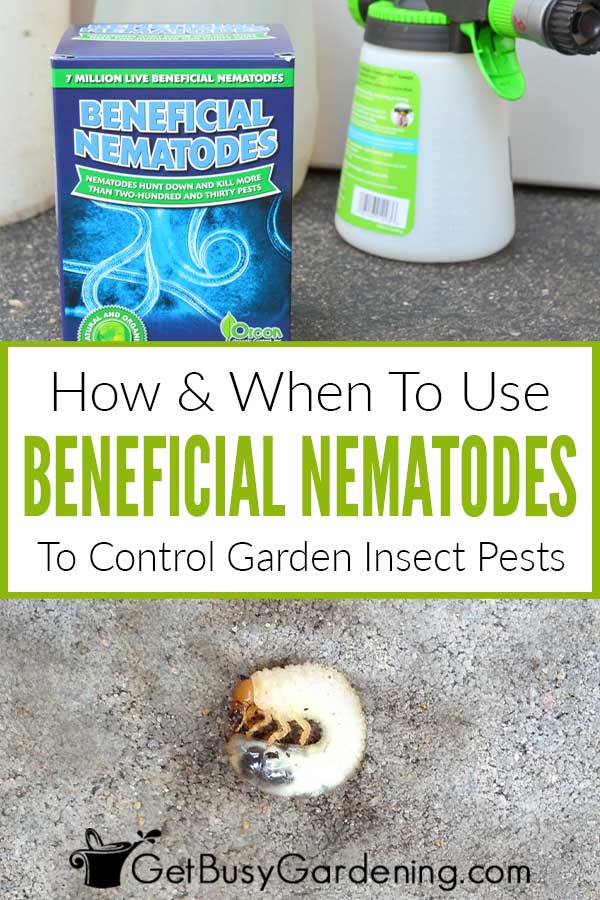
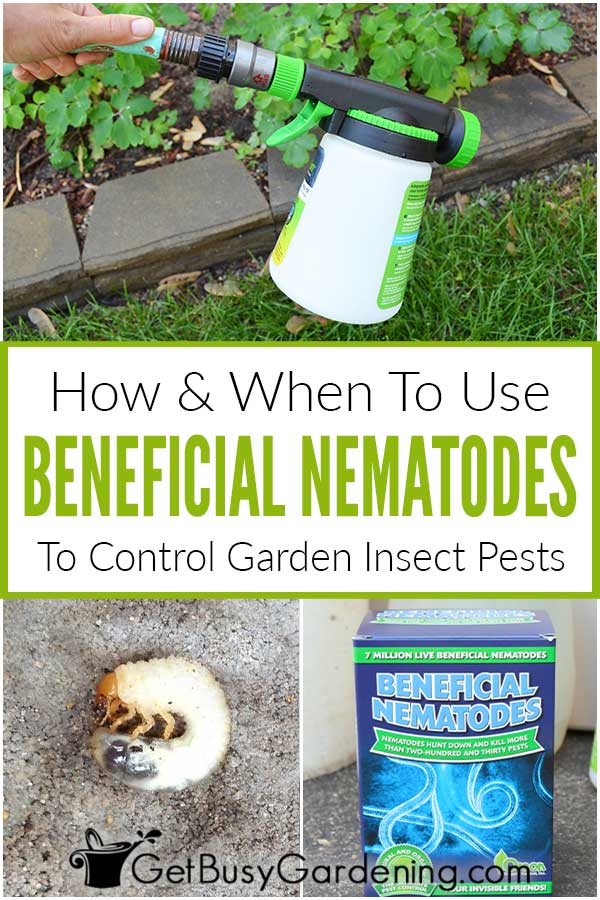
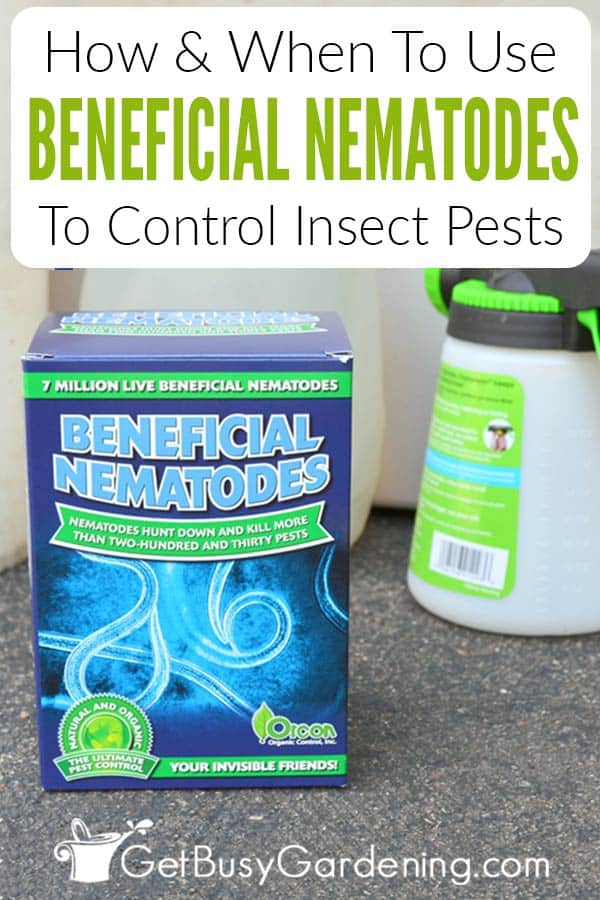

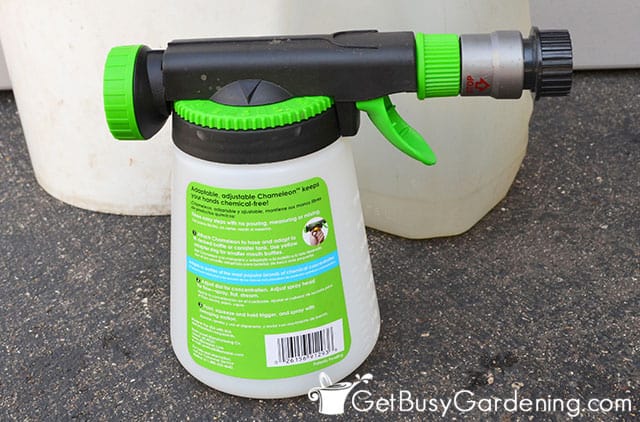
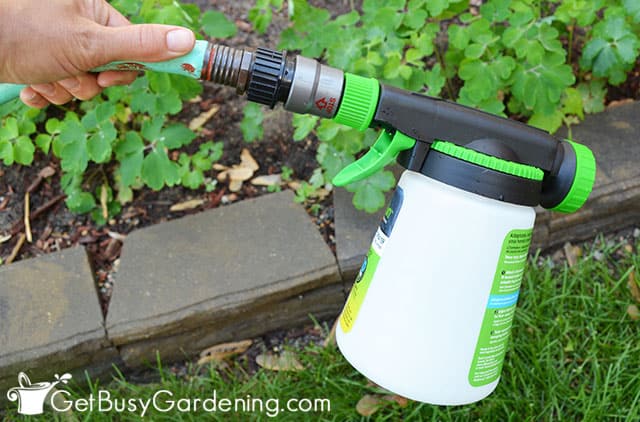

francine andrews says
Can nematodes be applied around pine trees for the beetles that ruin them? Thank you.
Amy Andrychowicz says
Yes, Heterorhabditis bacteriophora (Hb) nematodes are most effective against beetles, so make sure the ones you get contain them.
Cynthia Finkelstein says
Will beneficial nematodes kill melitia cucurbitae?
Amy Andrychowicz says
Yes, the squash vine borer (melittia cucurbitae) larvae is on the list of bugs that the beneficial nematodes that I have linked to in this post can kill.
Cynthia Finkelstein says
Yippie! Thank you. The melitia cucurbitae is my arch nemesis…
Amy Andrychowicz says
You’re welcome, it’s mine too! Here are additional tips I use to rid of them and keep them from killing my plants… How To Get Rid Of Squash Vine Borers Naturally.
Cerise says
Can the nematodes survive in potted vegetable gardens? Do they tolerate heat?
Amy Andrychowicz says
Yes, beneficial nematodes can survive in potted plants, as long as the soil stays moist. They can’t tolerate extreme heat, and will start to die if the soil gets over 85-90°F (which is pretty hot for your plants to withstand too).
Karl says
Do beneficial nematodes kill the bad nematodes that attack the roots and stems of plants and vegetables?
Amy Andrychowicz says
Yes, as long as you purchase the correct strain, beneficial nematodes will kill all of the bad nematodes.
Sue Bailey says
I have been having a lot of grubs, about 35 a day, crawling into my pool here in VA for the last couple of weeks. Are beneficial nematodes safe to spray around the pool?
Amy Andrychowicz says
Yes, beneficial nematodes are harmless to humans and pets. I recommend spraying them evenly throughout your yard to help kill the grubs.
Pamela says
I have discovered onion maggots and iris borers this year. My squash have been affected by the squash vine borer as usual this year. Will applying the nematodes help with all of these? I don’t think the onion maggots came from my soil because it was all new soil in raised beds and they affected those onions along with the onions not planted in the new beds.
Amy Andrychowicz says
Yes, as long as you get the right type of beneficial nematodes that target the specific pests you’re trying to control. The package should tell you which species is included in there, and exactly which pest they are targeting.
Cj says
Which type is classified as beneficial? They are round worms which are harmful to horses.
Amy Andrychowicz says
Don’t worry, the beneficial nematodes that are sold for organic garden pest control only attack soil-dwelling insects. They do not harm animals.
Dixie says
Will nematodes kill locust larvae? Here in SW Wyoming we have problems with locusts and J Beetles.
Amy Andrychowicz says
Yes, beneficial nematodes will indeed kill locust larvae. They attack and kill any type of grub worm in the soil. 🙂
Ellen says
Is it ok to feed those nasty grubs to the fish I have a pond in my back yard and I throw those suckers to the fish
Amy Andrychowicz says
Yes, fish love eating worms of any kind, and the nematodes won’t harm the fish at all. 🙂
Bridget says
Where do you buy your nematodes? I’ve ordered them before, but was wondering if any MN stores carry them.
Amy Andrychowicz says
Yes, Bachman’s carries them.
Lynne says
I’ve been wanting to use these guys in my yard. I read they kill slugs too. I just scraped over 200 slugs out from under my pavers. How gross!! Definitely getting nematodes!
Amy Andrychowicz says
Holy smokes, that’s disgusting! I hope the nematodes work for you!!
James says
I’ve used Nemaslug nematodes in the past, and they have worked well for me.
Kim~madeinaday says
Those beetle are pesky, thanks for showing how to use nematodes to get rid of them.
Amy Andrychowicz says
You’re welcome.
Donna says
Something I will have to note for the future…the J beetles I think may be delayed due to the cool weather.
Amy Andrychowicz says
Yes, beneficial nematodes are definitely a great, organic solution to get rid of the nasty bugs!
Maria says
Thanks for this post! I've been looking into these for our very "generous" population of Japanese Beetles. I will be anxious to see if you notice a difference. Looking forward to getting to know your blog as well!
Amy Andrychowicz says
You’re welcome! Yes, they have definitely made a noticeable different in the JB population, and other bad bugs as well!
Carlee says
I haven't used beneficial nematodes, but I'm curious to find out your results. Please do share!
Amy Andrychowicz says
Yes, using beneficial nematodes has made a noticeable difference in the flea beetle population, and the JB population seems lower too. Hope you’ll give them a try.
Brigitte Frank says
I use diomatacious earth against all kinds of beetles.
Amy Andrychowicz says
Yes, that is effecting at killing them too. But, there are more good bugs than there are bad, so be careful not to kill the good ones in the process. 🙂